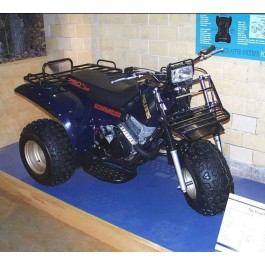Browse By
|
Polaris ScramblerDescriptionPolaris Scrambler.The Polaris 250 Scrambler was Polaris’s Entry in the well Established Three wheeler Market, currently dominated by Honda and their ATC trikes. Unlike any major ATV at the Time, Polaris was the first to offer an ATV with a fully Automatic CVT transmission. Dubbed “PVT” (Polaris Variable Transmission), It used 2 pulleys, one variable, and a belt, this setup was adapted from their snowmobiles, along with the engine itself, a 250 CC Air cooled 2-Stroke manufactured by Fuji Heavy industries (AKA, Subaru). the engine is Snappy, with a nice power-band, and easily delivers the rather portly 386 pound machine to 58 Mph. This was the only 250cc two-Stroke that was not on a Racing trike, and it was well mannered enough for an average rider. The Oil injection feature was a nice touch, although not unique to polaris. this allows the user to fill the tank with regular gasoline, no mixing required. the user fills a separate tank with oil, and the machine mixes the fuel itself . The rear drive was chain driven, and the Gear Selector was a hand lever mounted up high, with a simple F-N-R configuration. This Setup allowed them to use full-length Foot boards, instead of the Foot pegs used (and required by) other machines of the time, and allowed Polaris to mate the rear fenders flush with the Foot rests, a welcome Safety feature, which kept the riders feet well away from the rear wheels. This was also used on the Trail Boss four wheeler. Up front, the Front fork was courtesy of Yamaha, a modified Tri- Moto YTM 225DX triple with Showa Shocks and sealed drum brakes, also Yamaha. Fortunately for most, the Yamaha’s “Whirpool Twist” twist throttle was replaced with a more manageable thumb unit. The rear brake was disc. the rear brakes worked well, even though the front brakes were not the best. The trike cost $1968 (USD,) in 1985 and 1986, rather high when compared to Honda’s offerings, and sales only approached 1600 units, and they were only produced for the 1985 and 1986 model years, making them a rarity today. Detailed Information
Additional InformationAdditional Information
|



